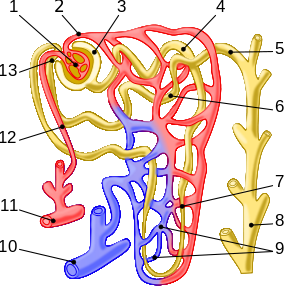Nephrons
| Nephron | |
|---|---|

Nephron of the kidney. The labelled parts are 1. Glomerulus, 2. Efferent arteriole, 3. Bowman's capsule, 4. Proximal convoluted tubule, 5. Cortical collecting duct, 6. Distal convoluted tubule, 7. Loop of Henle, 8. Papillary duct, 9. Peritubular capillaries, 10. Arcuate vein, 11. Arcuate artery, 12. Afferent arteriole, 13. Juxtaglomerular apparatus.
|
|
| Details | |
| Precursor | Metanephric blastema (intermediate mesoderm) |
| System | Urinary system |
| Identifiers | |
| Latin | Nephroneum |
| MeSH | Nephrons |
| FMA | 17640 |
|
Anatomical terminology
[]
|
|
The nephron (from Greek νεφρός – nephros, meaning "kidney") is the basic structural and functional unit of the kidney. Its chief function is to regulate the concentration of water and soluble substances like sodium salts by filtering the blood, reabsorbing what is needed and excreting the rest as urine. A nephron eliminates wastes from the body, regulates blood volume and blood pressure, controls levels of electrolytes and metabolites, and regulates blood pH. Its functions are vital to life and are regulated by the endocrine system by hormones such as antidiuretic hormone, aldosterone, and parathyroid hormone. In humans, a normal kidney contains 800,000 to 1.5 million nephrons.
Each nephron is composed of an initial filtering component (the "renal corpuscle") and a tubule specialized for reabsorption and secretion (the "renal tubule"). The renal corpuscle filters out solutes from the blood, delivering water and small solutes to the renal tubule for modification.
Composed of a glomerulus and the Bowman's capsule, the renal corpuscle (or Malpighian corpuscle) is the beginning of the nephron. It is the nephron's initial filtering component.
The glomerulus is a capillary tuft that receives its blood supply from an afferent arteriole of the renal circulation. The glomerular blood pressure provides the driving force for water and solutes to be filtered out of the blood and into the space made by Bowman's capsule. The remainder of the blood (only approximately 1/5 of all plasma passing through the kidney is filtered through the glomerular wall into the Bowman's capsule) passes into the efferent arteriole. The diameter of efferent arterioles is smaller than that of afferent arterioles, increasing the hydrostatic pressure in the glomerulus.
...
Wikipedia
